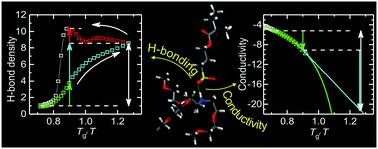当前位置:
X-MOL 学术
›
Soft Matter
›
论文详情
Our official English website, www.x-mol.net, welcomes your
feedback! (Note: you will need to create a separate account there.)
Hydrogen bonding and charge transport in a protic polymerized ionic liquid.
Soft Matter ( IF 2.9 ) Pub Date : 2020-06-09 , DOI: 10.1039/d0sm00337a Arthur Markus Anton 1 , Falk Frenzel 2 , Jiayin Yuan 3 , Martin Tress 4 , Friedrich Kremer 2
Soft Matter ( IF 2.9 ) Pub Date : 2020-06-09 , DOI: 10.1039/d0sm00337a Arthur Markus Anton 1 , Falk Frenzel 2 , Jiayin Yuan 3 , Martin Tress 4 , Friedrich Kremer 2
Affiliation

|
Hydrogen bonding and charge transport in the protic polymerized ionic liquid poly[tris(2-(2-methoxyethoxy)ethyl)ammoniumacryloxypropyl sulfonate] (PAAPS) are studied by combining Fourier transform infrared (FTIR) and broadband dielectric spectroscopy (BDS) in a wide temperature range from 170 to 300 K. While the former enables to determine precisely the formation of hydrogen bonds and other moiety-specific quantized vibrational states, the latter allows for recording the complex conductivity in a spectral range from 10−2 to 10+9 Hz. A pronounced thermal hysteresis is observed for the H-bond network formation in distinct contrast to the reversibility of the effective conductivity measured by BDS. On the basis of this finding and the fact that the conductivity changes with temperature by orders of magnitude, whereas the integrated absorbance of the N–H stretching vibration (being proportional to the number density of protons in the hydrogen bond network) changes only by a factor of 4, it is concluded that charge transport takes place predominantly due to hopping conduction assisted by glassy dynamics (dynamic glass transition assisted hopping) and is not significantly affected by the establishment of H-bonds.
中文翻译:

质子聚合离子液体中的氢键和电荷传输。
质子聚合的离子液体聚[三(2-(2-甲氧基乙氧基)乙基)丙烯酰氧基丙基磺酸铵](PAAPS)中的氢键和电荷传输是通过将傅立叶变换红外光谱(FTIR)和宽带介电谱(BDS)结合起来研究的温度范围从170到300K。前者可以精确确定氢键的形成和其他特定于部分的定量振动状态,而后者则可以记录10 -2至10 +9光谱范围内的复电导率赫兹。与通过BDS测量的有效电导率的可逆性形成鲜明对比的是,氢键网络形成过程中观察到明显的热滞现象。基于这一发现以及电导率随温度变化一个数量级这一事实,而N–H拉伸振动的积分吸光度(与氢键网络中质子的数量密度成正比)仅变化了一个因数为4,可以得出结论,电荷传输主要是由于玻璃态动力学辅助的跳跃传导(动态玻璃化转变辅助跳跃)引起的,并且不受H键建立的明显影响。
更新日期:2020-07-08
中文翻译:

质子聚合离子液体中的氢键和电荷传输。
质子聚合的离子液体聚[三(2-(2-甲氧基乙氧基)乙基)丙烯酰氧基丙基磺酸铵](PAAPS)中的氢键和电荷传输是通过将傅立叶变换红外光谱(FTIR)和宽带介电谱(BDS)结合起来研究的温度范围从170到300K。前者可以精确确定氢键的形成和其他特定于部分的定量振动状态,而后者则可以记录10 -2至10 +9光谱范围内的复电导率赫兹。与通过BDS测量的有效电导率的可逆性形成鲜明对比的是,氢键网络形成过程中观察到明显的热滞现象。基于这一发现以及电导率随温度变化一个数量级这一事实,而N–H拉伸振动的积分吸光度(与氢键网络中质子的数量密度成正比)仅变化了一个因数为4,可以得出结论,电荷传输主要是由于玻璃态动力学辅助的跳跃传导(动态玻璃化转变辅助跳跃)引起的,并且不受H键建立的明显影响。











































 京公网安备 11010802027423号
京公网安备 11010802027423号